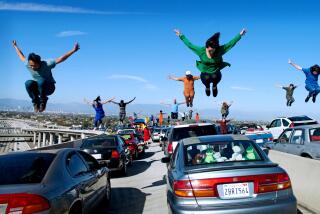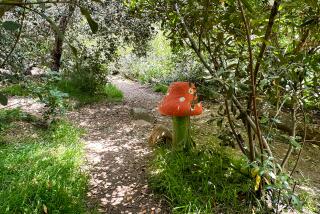Los Angeles State Historic Park is about to open after 16 years of delays
Community activists won a victory in 2001 when an abandoned downtown rail yard slated to become an industrial center was instead sold for use as a park in the historic heart of Los Angeles.
They’ve been waiting ever since for an urban oasis to blossom on the 32-acre site sandwiched between Chinatown and the Los Angeles River and surrounded by neighborhoods that have been ports of entry for L.A.’s immigrant populations for nearly two centuries.
Stalled in the budgeting and construction stages for 16 years, the new Los Angeles State Historic Park will celebrate its grand opening on Saturday.
On Monday, Sean Woods, superintendent of the park, gave an approving nod to crews pruning trees and sweeping walkways in preparation for the event.
“Beautiful, isn’t it?” he said. “You’re looking at a new place downtown for public gatherings, flying kites, kicking a ball and just getting away from it all. It’s also a center for pondering the city’s dynamic cultural history – warts and all.”
The site is where a Spanish expeditionary force led by Capt. Gaspar de Portola forded the river in 1759 and set up a base camp near the Native American village of Yang-Na.
You’re looking at a new place downtown for public gatherings, flying kites, kicking a ball and just getting away from it all.
— Sean Woods, superintendent of Los Angeles State Historic Park
Across the land ran the Zanja Madre, a web of brick and mortar conduits fed by a large water wheel that carried irrigation water in the young city.
Entombed in dirt and time are remnants of a passenger station built in 1876 to serve the newly arrived Southern Pacific Railroad.
A few blocks away, racial tensions came to a head when, on Oct. 24, 1871, a mob of 500 whites killed 19 Chinese men and boys, 15 of them by hanging. Known as the Chinese Massacre, the killing rampage prompted newspapers across the nation to liken Los Angeles to a bloodstained Eden.
Old-timers in the area remember when developers and city officials in the 1950s forced more than a thousand families out of Chavez Ravine, just north of the park, to build the stadium where the Dodgers now play.
In the 1990s, the site became a weedy battleground of lawsuits, frustration and anger over the city’s plan to transform it into an industrial and warehouse center. Yielding to intense pressure from a group of environmentalists and community activists called the Chinatown Yard Alliance, Gov. Gray Davis in 2001 authorized California State Parks to acquire the land.
Now it is an expanse of 1,500 trees, grassy hills, picnic areas and wildlife habitat built with $20 million in voter-approved Proposition 40 bond funds as a centerpiece of downtown enhancement.
Some politicians and urban planners see the park, which is about a 10-minute walk from City Hall, as a model for solving land use battles in metropolitican areas statewide.
“It’s not New York’s Central Park,” George Yu, executive director of the Chinatown Business Improvement District, said during a tour of the grounds, “but it’s central to us as Angelenos.”
Elva Yanez, a state parks commissioner, added: “There’s a lot riding on this park’s success. If all goes according to plan it could spark more investment in similar projects throughout the state.”
A state-sponsored network of trained local supporters has been spreading the word at schools, community centers and churches, and fielding concerns that the new park will draw new residents to the area, pricing low-income neighbors out of their homes.
Among these supporters is Deborah Miller, 40, a mother of five who lives in the nearby William Meade Housing Project.
“I’ve been handing out flyers and telling everyone I can, ‘Come check us out,’” Miller said. “This park is beautiful, I tell them, it was made for us.”
The park has helped inspire a wave of development around its perimeter: a gym, a brewery, restaurants and housing.
State parks officials are trying to secure funding for a second phase of development at the park that will include pedestrian bridges linking it to a nearby Gold Line Station.
“Everywhere you look, there are signs of gentrification with a capital G,” said Connie Vuong, a trained park supporter living in Chinatown who formerly worked for a foreign investment firm.
Lauren Bon, an artist and director of the Annenberg Foundation, one of the world’s largest family philanthropic organizations, is seeking permission to build a 70-foot water wheel to draw water from the river and feed a network for irrigating nearby green spaces, including the park.
“The opening of this park is only the beginning,” Woods said. “Our goal is to exist as a reflection of the living, palpable procession of cultural and natural changes in the beating heart of one of the great cities on Earth.”
ALSO
The trees that make Southern California shady and green are dying. Fast.
More to Read
Sign up for Essential California
The most important California stories and recommendations in your inbox every morning.
You may occasionally receive promotional content from the Los Angeles Times.











